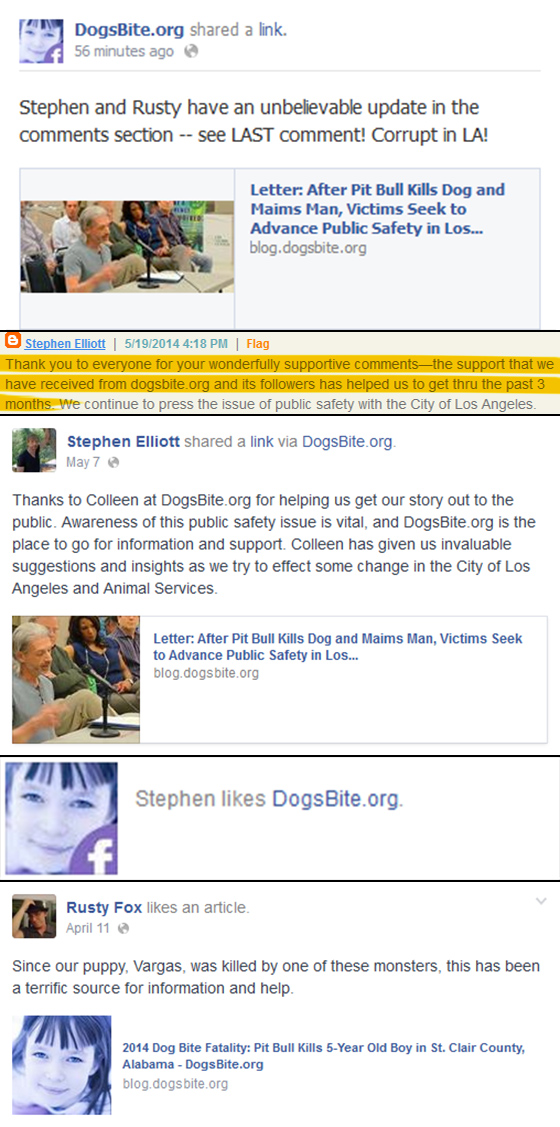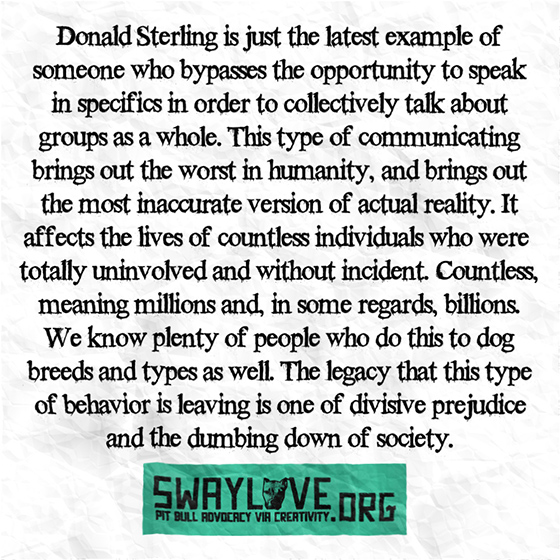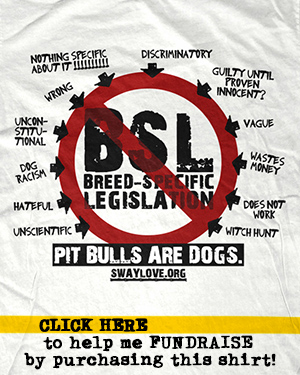Breed-specific legislation affects both dogs and people. The most accurate distinction is that it’s prejudicial to both massive groupings of dogs and the many different people that have them as pets. It is a means to an end, the end being the end of the breed or type’s existence, and 1 way or another. It’s also a tool commonly used to excuse racial profiling against people, further hindering certain communities that some politicians or law enforcement agency members may deem undesirable. This creates both a disparate impact amongst these communities and a disparate treatment of those communities. More so the treatment, because alas, discriminatory intent is usually evident. In regards to the dogs (Pit Bulls), nothing is being based on their actions, deeds or individual histories. They are thus being treated in the exact opposite way… Defined by their looks and the erroneous stereotypes/entrenched biases that roll through culture. We all know that this type of thinking is an injustice and wrong, yet it’s overlooked in this realm when convenient for a dog-banner.
So in the following text I hope to show you more definitively how breed-specific legislation is being purposefully used to target not only dogs, but certain factions of our communities as well. I’ll specifically delve into Lancaster, Chicago, Lake Elsinore and Riverside County respectively, and please take the time to consider the points that are made along with the many available words that are taken from those who are/were actually pushing the legislation. At the end of this writing I will then ask you to come back up to this exact point and re-read what you are about to read (in the below quoted box, 5 paragraphs). It should all make a great amount of sense…
Kim Wolf of Beyond Breed first made me aware of this study which was written by Northeastern University professor Arnold Arluke and appeared in the “International Journal of Sociology and Social Policy” back in 2003.
It’s within this extremely insightful writing (pages 10-13 of the document, 35-38 of the overall study) where Arluke aligns the concepts of racial profiling and dog breed profiling, stating that police departments have begun using dog breed profiling as a conduit in order to racially profile people from certain neighborhoods.
In at least one major metropolitan area, this changed after the local humane organization’s law enforcement department created a collaborative relationship with the city’s police force. Both departments discovered law enforcement opportunities in the same Pit Bull cases. Although cruelty was the point of entry for humane officers, drug-related offenses were for regular police. At first, this collaboration was informal and serendipitous. Animal cops discovered that when investigating some cruelty cases involving Pit Bulls in inner-city settings they also saw evidence of illicit drugs on the premises, and would call regular police to alert them and get them involved. In one such case, the investigating animal cop found a pile of ‘suspicious dirt’ next to ten Pit Bull puppies in a cruelty case. Regular police were eager to also investigate the possible drug angle and were glad to have been called in after they discovered a substantial amount of crack cocaine on the premises. This collaboration was formalized when an interagency task force was created between these two departments that sought to reduce the use of vicious dogs as gang weapons or ‘mules.’ For the police, their interest initially was to confiscate deadly weapons possessed by suspected gang members. The humane organization’s interest was to take dogs away from owners who were thought to seriously endanger their animals’ welfare.
To accomplish their overlapping aims, members of this task force carried out joint ‘sweeps’ in suspected inner-city neighborhoods to spot ‘suspicious’ dog owners and ‘disarm’ them by taking their animals. Driving through certain high-risk urban neighborhoods allowed for opportunistic spotting of African Americans walking with Pit Bulls on sidewalks or sitting on stoops with their animals, the assumption being that these dogs were not mere pets but illegal and dangerous weapons. Task force members would ask if dogs were properly licensed and, if not, seize and take them to the local shelter. Of course, the apparent owner was told that a license could be applied for if proper forms were completed, including name, address, and phone number, all to be verified. However, task-force members believe that these individuals do not want to show their licenses if they have them or apply for new ones if they do not, in order to remain anonymous from authorities.
The work of this task force appears to have reduced the use of Pit Bulls as weapons or accomplices, claim officers. Because of task-force sweeps, an inner-city owner of a Pit Bull now knows that walking down the street with his animal will not be overlooked by authorities because it is ‘just a dog,’ and instead might result in charges of carrying a weapon or violating the cruelty law. They also now know that they will be expected to care for the animal, have it licensed, vaccinated and checked by veterinarians, making ownership more of a hindrance to them. Of course, ‘success’ of such sweeps constitutes a drop in observed African American-Pit Bull interaction on the streets; there is no way to know whether exploitive use of these dogs has actually lessened in terms of their use in dog fights or as drug guards or couriers. Word of their apparent success has traveled within the police community; officers around the state and country are starting to view this task force as a ‘model program’ to emulate in their own municipalities since the ‘Pit Bull problem’ is increasingly recognized as a growing and uncontrolled problem in urban, inner-city neighborhoods throughout the nation.
Study of such a program offers a number of research prospects for sociologists. One that is glaring would be to explore whether and how task-force activities involve a novel form of racial (and breed) profiling. Extending the well-documented practice of using racial profiling to stop certain car drivers, racial profiling in the present case is used with pedestrian walkers who fit both the person and animal criminal profile. Because it is unique, recent, and unknown to the media, this form of racial profiling has escaped attention by both news reporters and academics. Such neglect is unfortunate because this instance of racial profiling presents a rare opportunity to explore the ‘natural history’ and evolution of a single racial-profiling policy by a major metropolitan police department and humane law enforcement office.
Using the case of African American Pit Bull owners, sociologists can explore how racial profiling by police develops into policy and practice, becomes normalized and justified by officers and other authorities such as court official, and is exported to other municipalities. This question differs from prior studies of racial profiling that document its existence but do not help us understand the ‘underlife’ (Freidson, 1976) of these policies–all the social and cultural forces that take place in the background of public policies that citizens never see, but that are necessary to produce policy in the first place, make it understandable to those who carry our policy, and translate abstract ideas into concrete actions on the job.
Out in California we’ve seen this type of tactic be openly rolled out in the city of Lancaster, where Mayor Rex Parris bragged that he hoped to “deliberately harass” gang members who “favor” the dogs, and went on to create ordinances that would demonize them (MSN-BSL), and on top of that, seek to stiffly penalize owners of “potentially dangerous” and “vicious” animals upon the questionable branding of such a label coming from a hearing officer.
Notice how there’s no definition of what being a gang member actually constitutes when being used in this loose context… We all know what it means to be a “gang member” if there is actually sufficient evidence to back up such a classification. But how many times is this term just thrown out there, by prejudicial characters, as a blanket labeling of black or Latino communities? This happens. Going back up to the Arluke study… You don’t think that the use of “inner-city neighborhoods” and “urban neighborhoods” by the tasked police departments aren’t potentially substitute terms for African American and Latino?
I’m certainly not trying to be a wording or phrasing doctor, but we must also acknowledge that this mentality does exist amongst some. That is not an indictment of everyone (supporters, police, politicians, animal control). But rather a piece of reality meant to be considered when investigating individual incidents of such combined behaviors.
Here’s the full quote coming from Mayor Rex Parris in 2009…
I want gangs out of Lancaster. I want to make it uncomfortable for them to be here. Anything they like, I want to take it away from them. I want to deliberately harass them. It’s really like gangs having a weapon that they are allowed to display and intimidate people. If they have a Pit Bull, they may as well put a sign on their head saying, ‘Come get me.’ If they move on to cats I’m going to take their cats.
Make no mistake about it, I’m no apologist for gang or criminal activity. I find violent and divisive gangs as abhorrent as any other thing on the planet. However, what and who I’m attempting to speak up on behalf of is all of those innocent folks who are getting swept up into such a categorization. To outright deny that this type of profiling doesn’t happen, isn’t happening, is really dismissive. Obviously gangs can include any person from a myriad of ethnic backgrounds. Yet the existence of such a tactic still remains prevalently focused on African Americans and Latinos.
Further, notice how certain types of dogs, at the behest of Parris, are just automatically targeted through as much legislation as the state of California currently allows. This is done by both mandating their sterilization (backed by high fines and no resources) and having a hearing officer be able to consider your dog “potentially dangerous” or “vicious” prior to that dog ever doing anything to justify such a labeling (again, backed by high fines and no resources). You think this system will not target people, and through that, then move to pass over any notion of due process or evidence in order to target their dogs? That is exactly what Lancaster Mayor Rex Parris has blatantly admitted to doing! Do you think that they care about sufficient evidence, or fear a lawsuit coming from any member of a targeted community? Clearly they don’t fear lawsuits coming from the majority of folks, not because they don’t have a case, but because they can’t afford it. I certainly couldn’t afford an attorney my damn self.
*In 2011 (latest numbers) the estimated per capita income of someone living in Lancaster was $19,154. The national poverty level for 2014 is a ridiculously low $11,670 but we all know how people making far more than that can genuinely struggle to remain above water, and especially in the state of California. The city of Lancaster is also at least 57.7% African American or Latino, which speaks to some of the possibilities that I was talking about earlier. I also touched on aspects of this topic in my 2013 debate with Riverside City Councilman Mike Gardner. It was during this debate that Gardner admitted: “Fair or not, the public perception does help drive the political will that allowed this for Pit Bulls.” Hello!
If you haven’t learned by now, these departments continue doing what they are able to get away with. If they are able to break the law, they sometimes will. If they are able to use intimidation and bush league tactics to color the law, they sometimes will. Just because they are able to get away with it, that doesn’t make it right. But unfortunately that is the belief system that might be prevailing inside of their own heads.
More from Parris, the same interview…
I’m willing to bear the weight of some injustice. Even if people who are not gangbangers have their Pit Bulls taken away, it means that these beasts are off the streets. And they are indeed beasts. They’re not Toto.
^Bold intent.
Then there’s these quotes, attributed to Rex Parris from a 2008 Antelope Valley Press article that has since been scrubbed from the internet…
Instead of picking the dogs up, people get warnings and citations, and when you hand out citations, people fix the problem and we still have the Pit Bull.
^That speaks volumes towards intent. Even under the premise of a fixable citation, which would come to fruition through available resources and community outreach, Parris still wouldn’t give a shit. He wants the Pit Bull gone. The problem to him isn’t individual incidents that are actually problems, but rather that these dogs are allowed to exist.
The reality is, these dogs are different. They hurt people, and it’s usually children. The gangbangers have taken these dogs and used them to intimidate each other and regular citizens. We should get all vicious animals off of our streets, but this particular breed is more dangerous and is more vicious.
Then this happened in 2010…
At the Jan. 26 City Council meeting, Mayor R. Rex Parris recognized the efforts of the Los Angeles County Department of Animal Care and Control in ridding the City of more than 1,100 vicious dogs by presenting Lancaster Shelter Manager Danny Ubario with the key to the City.
Notice how more than 1,100 dogs are automatically labeled as “vicious” by this Lancaster publication. Just jumping the “potentially dangerous” designation, the vast (vast, vast) majority of which weren’t even that, and categorizing them all as blanketly vicious for the purpose of this glorified press release. A total of 1,138 dogs had been impounded at the time of this release, 362 of which were “voluntarily surrendered” by their owners in response to the ordinance. It’s not a far stretch to say that they were all killed, considering the environment and the circumstances. So they’re all done away with and then magically deemed “vicious,” just like that. Parris interestingly referenced “Toto” in a quote from the year before, he must wear magic slippers and have a wand as well.
Sidebar: Based on these claims, Parris and Ubario were both designated “heroes” by online Pit Bull-hate group DogsBite.org. Nice.
I’d also point to the date of the press release, 1/1/2010, which comes less than a year after they officially implemented such targeting tactics. The press release claims that “homicide, rape, robbery, and assault” has been reduced 45%, and that “overall gang crime” has dropped 41%. Can we get some context?
First off, what is “overall gang crime” and how is it tallied? That’s just an asinine claim, since there’s no way to accurately keep track of such a subjective thing. But to the first claim, let’s flesh out the actual data… In 2008 and 2009 there were 10 murders each year, in 2010 there was 7, in 2011 there was 4, and in 2012 there was 8. That press release was written on the 1st day of 2010, meaning they were going off of the numbers from 2009, equaling 10 murders, which is the exact same amount of murders from the previous year in 2008. Rape? 2008: 61, 2009: 60, 2010: 60, 2011: 42, 2012: 54. Robberies? 2008: 354, 2009: 322, 2010: 255, 2011: 273, 2012: 313. And assaults? 2008: 765, 2009: 584, 2010: 578, 2011: 532, 2012: 484.
As you can see, murder stayed the same until dropping in 2010, but then doubled from 2011 to 2012. Rape stayed the same until dropping in 2011, they then went up in 2012. Robberies slowly declined and then went up in 2011 and again in 2012. Assaults have declined each year. So from 2009-2010 murders and rape stayed the same, robberies declined by 32, and assaults declined by 181. Everything, outside of assault, has increased from 2011 to 2012, which is the latest documentation that this website provides. Also worth note: Burglaries, thefts, auto thefts and arson have all risen from 2011 to 2012. Just as fascinating, overall crime statistics were dropping each year from 2007-2009, leading up to Parris’ self-titled “Pit Bull sweep.” They continued to drop, albeit at a slower rate, and then rose again in 2012.
To round off the Parris-portion of this post, I’d like to include a portion of a 2009 Blue Dog State post that sums this up rather well…
Mayor Parris wants certain dogs, and certain dog owners, gone by sundown. Basing himself on HSUS’s ‘Pit Bulls are the preferred dog of gangbangers, drug dealers’ fake factoid, Parris and the city of Lancaster are proud of their new breed-specific mandatory spay and neuter ordinance. They see it as an anti-gang tool. Dog law? Or covert racism? Sucking up to his audience’s worst fears, Parris says he has no problem with calculated harassment of certain residents and welcomed the ordinance, which is based on extreme negative stereotypes of both dogs and owners.
A year prior to Lancaster, Chicago attempted the same type of thing. This failed, but was pitched by the Dean of the Chicago City Council, Alderman Edward Burke, in the same fashion…
When you drive down the street and see a gangbanger with all kinds of gang regalia walking along with two or three Pit Bulls, it’s pretty simple for the policeman to raise the dog’s tail and see whether or not it’s spayed or neutered. If it’s not, the gang member is in violation.
How easily does something like this then begin to equate completely innocent Pit Bull owners with being “gang members” in the eyes of some? This is basically a stereotypical nightmare, creating all kinds of problems for completely innocent people (and dogs), but also partially serves as a self-fulfilling prophecy when Pit Bulls are constantly being aligned amongst rhetoric regarding criminal activity. Both by attracting criminals to Pit Bulls, and by conditioning the average public that the alignment is thus factual in the most basic of terms. What does this do? Serve to continue the perpetuation of unjust stereotypes, both in the minds of non-involved people and in the hearts of actual criminals, the minority of which will be propped up as the evidence while the real and far beyond majority evidence (that millions upon millions of Pit Bulls exist that are owned by upstanding members of all communities and have not harmed anyone, ever) goes ignored.
Speaking further to Chicago, they are quite frankly the gun-violence capital of the world, yet they routinely have the most draconian and restrictive gun laws on their books. How’s that working out for you? Not good, since actual criminals have no desire to follow laws. For example, just 2 days ago a couple different neighborhoods were completely locked down after 6 shootings occurred in less than 48 hours.
Chicago’s run at dog-targeting was just an obvious pretext for racially profiling anyone who they’d deem to be gang members. Such a move will always be fraught with differing errors, and also taken advantage of by numerous departments, just as the Arluke study from 2003 pointed out at the start of this post. And all in an effort to crack down on gang violence without actually cracking down on gang violence, because they are ultimately scapegoating dogs instead.
Speaking of “scapegoating” and “gangsters” makes me want to put into print what Animal Friends of the Valleys manager Willa Bagwell told me back in March, amid considerations by the Lake Elsinore City Council (to whom she contracts with) to embrace breed-specific legislation. The Council has thankfully since tabled the issue and favored a plan of outreach instead. But anyways, Willa’s the same lady that oversees her shelter’s in-house breed prejudicial policy against Pit Bulls, which does everything short of outright banning their adoptions. Her troubling comments to me about the locations that she services is right in line with the social boxing up of people in totality…
We’re not in Pasadena, with an upper-class people. We’re out here with the little gangsters in Lake Elsinore. The little gangsters in Perris. It seems to offend you that I say gangsters, but that’s what we’re dealing with. That’s what we’re dealing with. Do you know anything about Lake Elsinore? It’s mainly tweakers, drug addicts on methamphetamines, and Perris is a lot of gangsters. Those are the people that are coming to our shelter wanting these dogs.
So Pasadena has no gangsters? And on the flipside of that, Lake Elsinore and Perris are full of gangsters and drug addicts? No and no. Yet she so brazenly speaks of entire cities in such a fashion. Not cool. Not accurate. Not fair.
This brings me to Riverside County, which I’ve actively been on the front lines of opposing for the past year. Their asinine BDL law (voted through on the back of a massive vilification campaign by the Board of Supervisors) is traveling from area to area, and many of us are opposing it wherever it lands. This was precisely the intention, just as County Supervisor Jeff Stone admitted the morning of their October vote…
Our goal after we pass the ordinance today is to pass it on to our 28 cities, so that we uniformly have some type of ordinance in place for the entire county. These dogs are being bred to be dangerous, to fight, to kill, and as a result we’ve seen a lot of terrible incidents, so it’s been a significant public safety problem for our residents.
More intent and justification, it’s right there. The only problem is that mandatory spay and neuter laws weren’t designed for public safety, they were created to counter overpopulation. So by using them in this manner they are openly circumventing the intent of the state law, which technically allows breed-specific sterilization laws but disallows bans or other regulations on the premise that any breed or type be sweepingly called dangerous or vicious. Still, they are getting away with sweepingly labeling them as dangerous or vicious, and then using that ignorant indictment as justification for the sterilization law. Not okay!
It’s now been brought to my attention that they are selectively enforcing this law, which we all knew would happen but just didn’t have the hard evidence, and demanding outrageous amounts of money through fines without offering the free or low-cost resources that would allow many folks to complete the desired tasks. This, of course, is resulting in dogs being surrendered to (or being impounded by) animal control, who will then eventually end up dead.
The workings of this legislation also renders low-income people “in violation” of such a law, prior to giving them a truly free or low-cost option to take care of the problem before being in violation. So to cut to the chase, the passing of this legislation in Riverside County (followed by Riverside City) immediately made all of their relevant residents criminals in the eyes of this law. Then the uniforms come knocking (when selectively enforcing it) with this type of an insinuation, treating people as if they are egregious lawbreakers. That, instead of educating the community and giving them legitimate options that they can afford, coupled with the means to take advantage of such options, helps no one.
Let’s bust a myth right quick: When being given genuine access to these resources people do actually take advantage of them, and voluntarily. Check out this video from July where over 500 people showed up for 40 free spay and neuter spots. And where? In the Coachella Valley! Those telling you that folks aren’t taking or won’t take advantage of these resources are lying to you. Speaking of the Coachella Valley…
Pictured below is a citation for 2 “Pit Bulls” who weren’t licensed, vaccinated, sterilized or microchipped, and all at a cost of $100 per infraction, per dog, totaling a fine of $819. These violations are “correctable” if showing proof of corrections within 20 days of the citation.
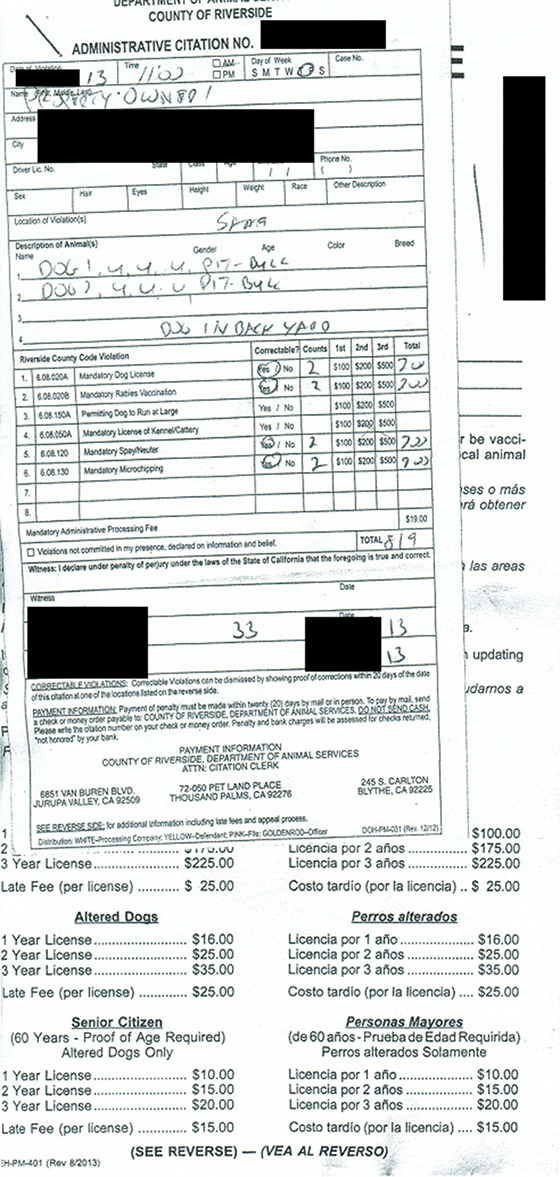
This one is for 2 Pugs, a Boxer and a Cocker Spaniel who weren’t licensed, vaccinated, sterilized or microchipped, and all at a cost of $100 per infraction, per dog, totaling a fine of $1,619. These violations are “correctable” if showing proof of corrections within 20 days of the citation.
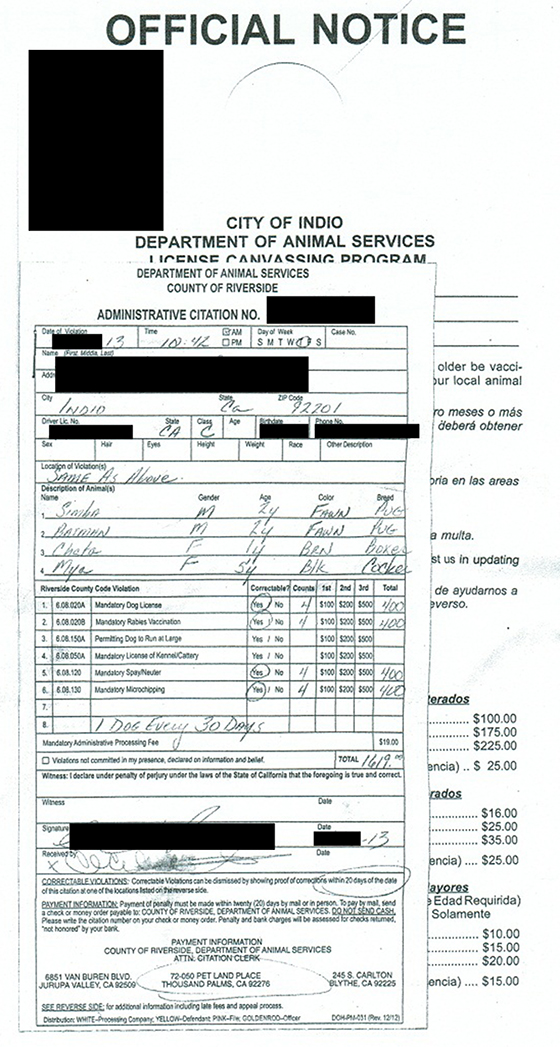
And this one is for a Chihuahua and 2 “small” white/black dogs who weren’t licensed, vaccinated, sterilized or microchipped, and all at a cost of $100 per infraction, per dog, totaling a fine of $1,219. Again, these violations are “correctable” if showing proof of corrections within 20 days of the citation.
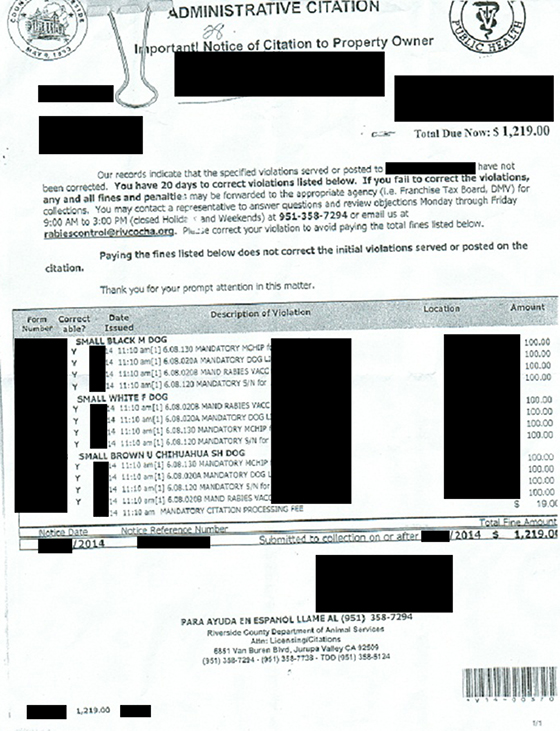
Putting aside the fact that these citations amount to extortion, did anyone else notice how none of them were in Spanish? I visited the Riverside County Department of Animal Services website, which you have to use in order to even attempt to comply, and there’s no Spanish option or translation component available online. The entire website is in English. This is all preposterous, considering many of those being cited have Spanish-speaking head of households! To be more specific, each of the citations pictured above were written by Riverside County’s animal control, to residents of the city of Indio. This city just so happens to be around 70% Hispanic, and many of these folks live in poverty. Yet no Spanish option? Really?
Making matters worse, it’s alleged by someone in contact with myself that since Indio closed its shelter in August of 2013, the City Council has “jumped into a contract with Riverside County without being fully aware of the terms and provisions of the contract.” This has obviously caused confusion with Indio’s residents, as the majority don’t even know that the shelter is closed. The city simply padlocked the building… With that, they posted no closing sign, left no notifications, and they posted no referral information for those showing up at any given time, some of which may have been trying to comply. A concerned resident printed up a document and went and posted it on the outside of the location, but it was blown away by the wind within a few days. After 6 months the building was knocked down in January without a single posting being visible at the location. As far as the transference of laws/contracts is concerned (more below), if their own City Council doesn’t know what they’ve found themselves in the midst of, how can the residents be expected to?
This, even as Indio is not an unincorporated city of Riverside County. It’s within my current understanding that Indio would need to pass either a mandatory sterilization law for all dogs or a breed-specific mandatory sterilization law before either could be enforced within the city. Yet Riverside County is treating Indio residents as if both already exist. Along with that, Indio residents are now being forced to pay double what every other city in the Coachella Valley apparently pays when it comes to licensing fees.
As you can see, 2 of the 3 citations that were sent to me included dogs who aren’t even listed as being Pit Bulls. Regarding the 1 that does list them as Pit Bulls: Even before enforcing a Riverside County-duplicated breed-specific law that the county passed in October, the city of Indio would have to separately vote such a piece of legislation into law first. They are an incorporated city of Riverside County, just as Lake Elsinore and Jurupa Valley are, cities that have both recently declined approving such a law. Well, guess what? Indio actually declined moving forth with such a law on 4/2/2014. So why in the hell is Riverside County enforcing a law that doesn’t even exist in this city? Dogs are being confiscated and killed, and these laws don’t even exist in Indio!
This is all apparently due to a shadowy alignment of animal ordinances, where Indio voted to take on Riverside County’s laws back on 6/19/2013.
Sadly, attorney Marla Tauscher also informed me that in actuality Riverside County has had a mandatory sterilization law for all dogs in place since 2009. Had I known this back in October it would have been the first thing out of my mouth when giving my public comment in opposition to the Riverside County Board of Supervisor’s desiring to target Pit Bulls with the same law. Trust me, I researched their code but must have only found outdated policies online. Sure enough, Section 6.08.120 of their current county code states that “no person may own, keep, or harbor an unaltered and unspayed dog or cat in violation of this section.” So not only was their breed-neutral dangerous dog law not being enforced, but this all-dog spay/neuter mandate was already in existence prior to their October vote on breed-specific spay/neuter.
These developments bring up many questions… With that law already on the books in Riverside County (for close to 5 years), what was the need for a breed-specific mandatory sterilization law? Pit Bulls are dogs, they would obviously fall under the already existing language. Why did shelter director Robert Miller and head veterinarian Allan Drusys both fail to mention this to the Board of Supervisors, both in their presentation on that day and in their public/private communications leading up to that day? Why did the Board of Supervisors not know, or fail to mention the existence of this all-dog law? If a mandatory sterilization law for all dogs went unenforced and/or did not result in the publicly stated responsibility-aligned outcomes that they desired then and desire now, how will the breed-specific law not have the same outcome?
And now questions relevant to Indio… How have they just retroactively adopted all of Riverside County’s animal codes when they are instead an incorporated city unto themselves? Is that legal, and especially without specific votes on such individual matters (and the opportunity for the public to debate them)? If the mass ordinance transference took place in June, but then Riverside County voted BSL into law in October, does that mean Indio now has BSL? And if so, why did the City Council then bring it up for a vote (which was canned) in April of 2014? Hmm… It was actually canned when a member of the public, while giving a comment prior to the Council’s deliberation, informed them that they already had a mandatory sterilization law for all dogs, the ordinance that was apparently adopted in June from the transference with Riverside County. The City Council literally had no idea. They have no idea what they are doing! So how is the public being informed on any of this? They aren’t.
We all deserve answers to every question that was just asked!
More broadly (relevant to both Indio and Riverside County), the majority of people now receiving these citations from Riverside County’s animal control are low-income folks, senior citizens, and homeless people. In a sarcastic twist, gated communities are not being targeted by such practices. Most affected residents are being intimidated by the threatened infractions and do not even have the means to access the website, know the requirements, or have transportation to the Coachella shelter in Thousand Palms. These people are being left with “green tags with yellow citations” that are placed on doors when there are dogs on the property. Most citations are “left without any contact with the pet owners” because animal control’s hours are the same as when most people are working. As you can also see on the citations, they are threatened with being taken to collections for non-payment of the fines as well as being reported to the tax board and/or the DMV. And again, it’s all strictly in English when many of them speak Spanish.
Going further…
Residents have complained that animal control is looking over their fences and banging on their windows and doors. Many Hispanics feel as if they are being racially profiled by the county. People walking their dogs (on a leash) are being stopped and asked for proof of the dog’s license, and when the owner can’t provide it the dog gets confiscated.
^What?!?! Not cited, but taken. This is means for a legal battle if I’ve ever seen one, especially to those in the city of Indio, where these laws don’t even exist, or at best, have come into fruition under some questionable premise.
Watch this KMIR investigation, which further details all sorts of accusations being made against the tactics of Riverside County’s animal control. The worst, stating that an animal control officer said that they were coming back the next day to search a woman’s house room to room. Of course they’d have no warrant to do such a thing, yet is violating the 4th Amendment even a concern for this department?
Continuing…
The timeline once a citation has been issued is unfair and unjust. 20 days is not enough time to find a solution to the citation. You also can’t comply within 20 days because there’s no open appointments! It is very difficult to find a low-cost spay clinic, especially for the female dogs. Most of the residents being targeted are bringing home $1,000-$1,500 per month. Any excessive cost is a hardship on the family. The cost of spaying/neutering, microchipping and shots can run a resident up to $500. Many residents have multiple dogs, so 20 days places an extreme stress on the owner. Their options are to ‘dump’ their dogs. Numerous places in Indio are now hot spots for dumping, especially schools and parks. Many owners are relinquishing their pets to the county and are being told that for $50 they will try and adopt them out and for $25 they will kill them. After 4 days the animals being relinquished are killed.
Killing animals upon intake, at an owner’s request, or under any other similar scenario is a violation of the state Hayden Act. I doubt Riverside County cares, as no one is there to have access to their untransparent ways and follow it up with a consistently funded lawsuit.
So to wrap up, as far as I can tell they are being given these choices: 1) Take care of the citations in the allotted time, paying substantial amounts to do so, but which allows them to keep their pets. 2) Miss the deadline, which then forces them to have to pay the massive fines on the citation (plus daily impound fees if an animal was impounded), or they will ultimately lose their pets. 3) Relinquish their pets to Riverside County. But wait… There’s another kicker to all of this: You still have to pay the citation fines, even if you ditch your animal or relinquish it to the pound. Residents are unaware of this and are finding it out after the fact. A Riverside County official has compared this process to the process of a “speeding ticket.” This leads me to the act that some are doing (unbeknownst of what I just said) in an effort to avoid having to pay the citations…
Some owners will take (and have taken) the initiative to get rid of their dogs by other means. This story, also tied to Indio, details how Riverside’s legislation is leading to a further number of dogs left for dead in an area pegged by residents as “dead dog alley.”
Per NoPitBullBans.com…
It’s called ‘dead dog alley’ because dogs are dumped there by owners who, in this case, can no longer affort to keep their dogs thanks to Riverside County’s breed-specific mandatory spay/neuter ordinance, and abandon them on the desolate dirt road where they frequently get run over.
With this, the Pet Rescue Center of Coachella recently put up signs and cameras to “prevent people from throwing their dogs over the wall.” Riverside County Supervisor John Benoit was “unavailable” for comment. That’s lovely, and convenient. This brings back October memories of Supervisor Jeff Stone saying that “if it’s an issue (cost) call our animal control office and we’ll find a way to get your dog spayed or neutered.” I bet Stone would be unavailable for comment on that as well. He will, however, always take a moment to malign all Pit Bulls in the media through his use of foolish and unsubstantiated rhetoric. A real gem of a man, with a treasure trove of character on any opposite day.




